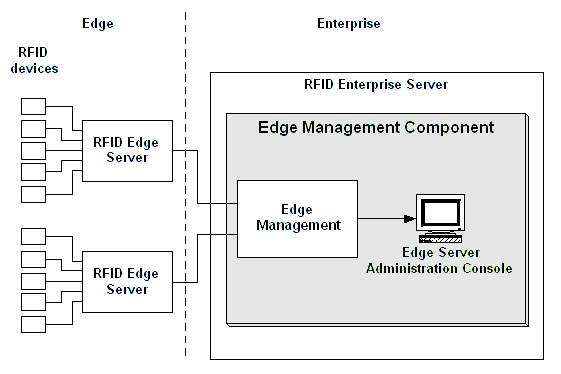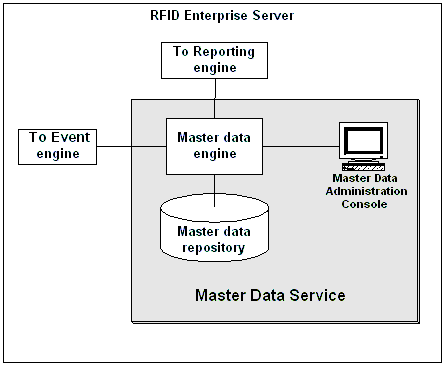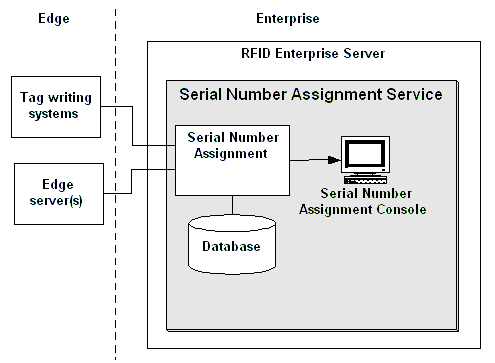









|
The following sections describe the architecture WebLogic RFID Enterprise Server:
Figure 3-1 provides an overview of WebLogic RFID Enterprise Server's components, services, and GUIs.

Applications running at the edge of the enterprise, such as the WebLogic RFID Edge Server, send EPCIS event data to the RFID Enterprise Server. This data provides basic information about when and where an RFID tag was read, plus additional information specific to the event type.
The Event Service receives the event data and interacts with the other subsystems to integrate the event data with master data (which provides business context) and to make the data available to the Reporting Service (for generating standard reports) and to the Data Exchange Service (for processing queries on the data and generating custom reports). Partners can subscribe to these custom reports.
The Serial Number Assignment Service provides the means for managing serial numbers distributed to the edge. The Edge Management component provides the means for monitoring and managing RFID Edge Servers.
Together, these components, services, and GUIs provide a comprehensive set of tools for working with RFID data at the enterprise level.
You can configure, monitor, and manage all the WebLogic RFID Edge Servers and RFID devices in your enterprise by using the Edge Server Administration Console included with RFID Enterprise Server. See Figure 3-2.

You can use the Edge Server Administration Console to:
For more information, see Edge Server Administration Console Online Help.
RFID Enterprise Server Event Service, Master Data Service, Data Exchange Service, and Reporting Service are closely integrated. The architecture of those services is shown in Figure 3-3 and described in the sections following.

Together these services provide the means to distill event data generated from the edge, associate master data (business-context information) with it, and then query both sets of data to provide a human-readable history of locations and transactions for an item or group of items.
| Note: | BEA's implementation of these services is based on the technically complete, but not formally ratified as of August 2006, EPCglobal EPC Information Services (EPCIS) Version 1.0 Specification. A currently available document, The EPCglobal Architecture Framework, provides a high-level description of the EPCIS architecture; it is available at: |
| Note: | http://www.epcglobalinc.org/ |
The Event Service captures EPCIS event data sent from the edge, stores it in the event data repository, and makes the data available for retrieval by the Data Exchange Service and the Reporting Service.
Incoming data is formatted as XML. The supported transport protocols for incoming data are JMS queues, HTTP, and SOAP.
At the edge, one or more WebLogic RFID Edge Servers or custom RFID applications can process and export EPCIS event data of the following event types. These types are all supported in RFID Enterprise Server.
All of the above event types share a four dimensional data model, in which any event may carry data relating to any of the following facets: the object to which the event occurred, when the event occurred, where the event occurred, and why the event occurred (that is, in what business context).
As Figure 3-4 shows, the Event Service receives EPCIS event data from one or more WebLogic RFID Edge Servers or custom applications, stores the data in the event repository, and interacts with the engines in other subsystems to integrate the data with master data and to make the data available to the Reporting Service and the Data Exchange Service.
| Note: | There is no GUI associated with the Event Service because the service does not require interactive input from administrators or users. Once its database and input mechanisms are configured for its host WebLogic Server, it accepts properly formatted event data input from the edge, stores the data in the event repository, and interacts with the other services without further user intervention. |

For more information, see Event Service in Understanding the Event, Master Data, and Exchange Services.
The Master Data Service provides the means for creating, managing, and storing master data, which provides contextual information for understanding EPCIS event data.
Raw EPCIS event data can be difficult to decipher when you encounter it directly. For example, bizLocation=urn:epc:id:sgln:0614141:33254.0 could be the part of an ObjectEvent that identifies where the event took place. Master data is descriptive information that can be associated with EPCIS event data to provide context that can be readily understood. For example, the above location identifier might be associated with this master data: 123 Elm Street, Burlington, Iowa, US.
Master data consists of master data types and master data entries. A master data type defines the characteristics that master data entries based on that type can have. RFID Enterprise Server includes several predefined master data types that can be used for common business processes. You can use these master data types as is, modify them, or define custom master data types to suit your business processes. The predefined master data types include:
The Master Data Service architecture is illustrated in Figure 3-5.
Master data is stored in the master data repository and is mapped to associated events in response to requests from the Data Exchange service and the Reporting Service. For the Data Exchange Service, master data is not returned as part of a query, but it can be specified in a query as a means for filtering the results. For the Reporting Service, master data is returned as part of a report.
You define, create, import, export, and otherwise manage master data through the Master Data Administration Console.

For more information, see Master Data Service in Understanding the Event, Master Data, and Exchange Services and Master Data Administration Online Help.
The Data Exchange Service (see Figure 3-6) processes queries and returns results to subscribers. An authorized user can create a subscription for an internal client or an external client, such as a business partner.
Each subscription defines the following:
Each time a query is run, the results are sent in XML format to the destination specified for that subscription via JMS, HTTP, or AS2.

You can create and manage subscriptions interactively using the Query Subscription Administration Console.
RFID Enterprise Server also exposes a query interface that allows applications to get access to EPCIS event data and associated master data. The query interface is available as a Web service for applications co-deployed with RFID Enterprise Server. Applications can query for events based on time, object identity (including EPC), location, and other dimensions. Queries may also refer to master data, allowing queries such as "find all events that took place in Chicago."
RFID Enterprise Server includes a number of built-in reporting options for viewing data in the event repository. The Reporting Service (shown in Figure 3-7) provides four types of reports, which are accessed via the Reporting Service Console:
There is no programmatic access to the Reporting Service; the Reporting Service console is the only way to generate reports. Therefore, you can view reports in and print reports from your Web browser.

For more information, see Generating WebLogic RFID Enterprise Server Reports.
The Serial Number Assignment Service (shown in Figure 3-8) provides centralized management for allocating blocks of unique serial numbers for tag writing systems running in multiple, remote facilities.
| Note: | In previous releases of RFID Enterprise Server, the Serial Number Assignment Service was called the Provisioning Service. |
Tagging applications running at the edge can request a block of unique object identities, and the RFID Enterprise Server responds, using a centralized database to insure that no serial number is assigned twice. RFID Enterprise Server can assign serial numbers in large blocks, which allows tagging operations to proceed at the edge with only infrequent communication with the enterprise server, or in small blocks, as needed. You can set up business rules that govern how serial numbers are assigned, such as reserving certain ranges of numbers for certain locations, applying different rules based on which product is being tagged, and so on.
For EPC-based applications, RFID Enterprise Server can assign SGTIN- and SSCC-type EPCs. The administration console provides a full history of past assignments, providing a centralized view of serial number consumption by product, by location, and so on.

For more information, see Using the Serial Number Assignment Service.


|